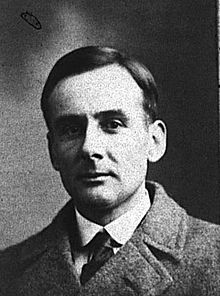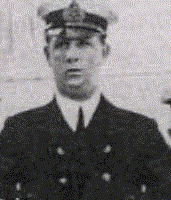Joseph Boxhall
Joseph Groves Boxhall Jr. (* 23. March 1884 in Hull , England ; † 25. April 1967 in Christchurch , England) was fourth officer of the Titanic , and later served as a naval officer in the First World War .
Life
Young years
Boxhall was born in Hull and was the second child of Mariam and Captain Joseph Boxhall sr. He came into contact with seafaring early on, as his family was a seafaring family. His grandfather was a seaman and his father was the head of the Wilson Line from Hull.
He followed in the footsteps of his ancestors and went on his first voyage on June 2, 1899 on a sailing ship of the William Thomas Line from Liverpool . Boxhall stayed on board for four years and got around a lot during that time. After leaving the ship, he worked for his father on the Wilson Line. After earning his Masters and Extra Masters degrees in September 1907, he left the Wilson Line to work for the White Star Line . He served the White Star Line on the ships Oceanic and Arabic before joining the Titanic as fourth officer at the age of 28 .
RMS Titanic
On March 26, 1912, like the other Titanic junior officers, he was summoned to the White Star Line office at 9 a.m. The next day he went to Belfast to board the ship. After casting off the Titanic on April 10th in Southampton , he went about his duties, which included supporting the passengers or the crew as well as navigating.
When the ship collided with an iceberg at 11:40 p.m. on April 14, Boxhall was on duty and with the officers' cabins . He heard the bell ringing in the crow's nest and immediately went to the bridge. He arrived there shortly after First Officer William M. Murdoch's unsuccessful evasive maneuver . Captain Edward John Smith , who arrived soon after , asked him to check the fore part of the ship. Boxhall could not find any damage and was then dispatched by Smith to have the ship's carpenter conduct a closer inspection of the ship. However, he met him soon after leaving the bridge and reported that the front compartments of the ship were quickly filling with water. Boxhall was then sent to fetch the second officer Charles Lightoller and the third officer Herbert Pitman . Then he should calculate the position of the Titanic .
At around 12:45 am, Boxhall and Quartermaster George Arthur Rowe began firing flares from a slightly angled rail near the bridge. The two of them shot them down until around 1:25 a.m. the stock of rockets was exhausted. During this activity, the two discovered a light on the horizon and tried to contact this light with a Morse code lamp, but they did not succeed. During a final conversation with the captain, Boxhall asked him if the situation was really serious, to which Smith replied that the ship would be sinking in the sea in about an hour to an hour and a half.
At 1:45 a.m. Boxhall was lowered into the water as the commander in lifeboat No. 2. After the sinking of the Titanic , he asked the women in the boat if they should go back to rescue survivors from the water, but they feared they would capsize and said no. However, the boat was only two-thirds full, so there would have been enough space to accommodate more people. When the RMS Carpathia was sighted, Boxhall lit small glow sticks to guide the ship towards them. His boat was the first to be recorded. Once on board the ship, Boxhall was ordered to go straight to the bridge, where he informed Captain Arthur Rostron that the Titanic had sunk at around 2:20 a.m.
Boxhall was questioned several times during the investigation into the sinking of the Titanic . He was one of the first to mention the unknown lights of a ship on the horizon that did not respond to signals from the Titanic . It may have been the Californian , but this has not yet been proven. See also: The Californian case
Another life and death

After the Titanic disaster, Boxhall first served as fourth officer on the White Star Line ship Adriatic before joining the Royal Naval Reserve. He was promoted to lieutenant in 1915 . During the war, he served a year on the Commonwealth warship before being sent to Gibraltar , where he commanded aboard a torpedo ship .
After the war, Boxhall married Marjory Beddells in March 1919, and two months later he returned to the White Star Line and became second mate on the Olympic . After the Cunard-White Star merger in 1933, he initially served as the first and later as the chief officer (on the Aquitania and the Berengaria , among others ) , but never became a captain in the merchant navy . After 41 years at sea, he retired in 1940.
Boxhall was a rather silent and quiet man and didn't like to talk about his experiences on the Titanic . Nevertheless, he helped with the British film A Night to Remember , which was shot in 1958 based on the book of the same name by Walter Lord , as a technical consultant and was also interviewed by the BBC in 1962 .
His health deteriorated rapidly in the 1960s until he was finally hospitalized. He was the last of the Titanic officers to die on April 25, 1967 from a cerebral haemorrhage at the age of 83. In order to fulfill his last wish, his ashes were dumped into the sea at coordinates 41 ° 46N 50 ° 14W - the position Boxhall had calculated as the final resting place of the Titanic half a century earlier .
Media
- Jack Watling played him in the 1958 film The Last Night of the Titanic .
- He was played by Warren Clarke in SOS Titanic from 1979 .
- In the television series Titanic (1996) he was played by Gerard Plunkett .
- He was played by Simon Crane in James Cameron's Titanic (1997) .
Web links
- Joseph Boxhall in the Encyclopedia Titanica
- Joseph Boxhall at titanic-titanic.com
- Joseph Boxhall tells of the sinking of the Titanic in his own words (audio document from 1962, approx. 18 minutes, BBC archive)
| personal data | |
|---|---|
| SURNAME | Boxhall, Joseph |
| ALTERNATIVE NAMES | Boxhall, Joseph Groves junior (full name) |
| BRIEF DESCRIPTION | Titanic's fourth officer and naval officer in World War I. |
| DATE OF BIRTH | March 23, 1884 |
| PLACE OF BIRTH | Hull , England |
| DATE OF DEATH | April 25, 1967 |
| Place of death | Christchurch , England |

